UNITED STATES
SECURITIES AND EXCHANGE COMMISSION
Washington, D.C. 20549
FORM N-CSR
CERTIFIED SHAREHOLDER REPORT OF REGISTERED
MANAGEMENT INVESTMENT COMPANIES
Investment Company Act File Number: 811-04521
| T. Rowe Price State Tax-Free Income Trust |
| (Exact name of registrant as specified in charter) |
| 100 East Pratt Street, Baltimore, MD 21202 |
| (Address of principal executive offices) |
| David Oestreicher |
| 100 East Pratt Street, Baltimore, MD 21202 |
| (Name and address of agent for service) |
Registrant’s telephone number, including area code: (410) 345-2000
Date of fiscal year end: February 28
Date of reporting period: August 31, 2017
Item 1. Report to Shareholders
 |
| New York Tax-Free Money Fund | August 31, 2017 |

The views and opinions in this report were current as of August 31, 2017. They are not guarantees of performance or investment results and should not be taken as investment advice. Investment decisions reflect a variety of factors, and the managers reserve the right to change their views about individual stocks, sectors, and the markets at any time. As a result, the views expressed should not be relied upon as a forecast of the fund’s future investment intent. The report is certified under the Sarbanes-Oxley Act, which requires mutual funds and other public companies to affirm that, to the best of their knowledge, the information in their financial reports is fairly and accurately stated in all material respects.
REPORTS ON THE WEB
Sign up for our Email Program, and you can begin to receive updated fund reports and prospectuses online rather than through the mail. Log in to your account at troweprice.com for more information.
Manager’s Letter
Fellow Shareholders
Tax-free municipal bonds produced solid gains and outperformed taxable investment-grade bonds in the six-month period ended August 31, 2017. The Bloomberg Barclays Municipal Bond Index returned 3.79% versus 2.74% for the Bloomberg Barclays U.S. Aggregate Bond Index, which tracks the taxable investment-grade bond market. Muni bonds were supported by steady demand and limited new issuance for most of the period. Longer-term municipals outperformed shorter maturities as the yield curve flattened, and lower-rated bonds outpaced higher-quality securities as investors continued to seek out higher yields. New York debt generally performed in line with the broad national muni index. The New York Tax-Free Bond Fund and New York Tax-Free Money Fund both produced positive results and performed roughly in line with their peer groups during the period.
ECONOMY AND INTEREST RATES
The U.S. economy grew at a strong 3.0% annualized rate in the second quarter of 2017, according to the Commerce Department’s most recent estimate—a pickup from the 1.2% growth rate in the first quarter. The labor market has been healthy, with the national unemployment rate easing to 4.4% in August. Inflation data were very weak in the early months of our reporting period, but pricing pressures more recently have shown signs of normalizing.
While Hurricane Harvey is having a significant impact on the highly populated and energy-dependent region around Houston, Texas, we believe the national economic effects of the storm will be short-lived. With regard to the municipal bond market, we believe that while Harvey may add some operating costs to impacted issuers over the short term, insurance, federal aid, and state support will provide enough assistance to local governments to allow them to recover without any significant long-term effects.
The Federal Reserve raised short-term interest rates in March and in June, lifting the fed funds target rate to the 1.00% to 1.25% range. The Fed has now raised rates four times since late 2015, and central bank officials expect to raise rates once more in 2017. The Fed is also poised to begin unwinding its $4.5 trillion balance sheet, a legacy of its massive purchases of Treasury bonds and mortgage-backed securities in the aftermath of the 2008 financial crisis.

Both the Treasury and municipal yield curves flattened in the first half of our fiscal year, with short-term municipal yields moving incrementally higher, while short-term Treasury rates increased to a greater degree, as they were more sensitive to the Fed’s rate hikes. Intermediate- and long-term yields decreased, with the move lower being more pronounced in the muni market. At the end of August, high-quality 30-year muni yields were slightly lower than the 30-year U.S. government bond yield. Nonetheless, municipals still offer relative value for many fixed income investors on an after-tax basis.
As an illustration of their relative attractiveness, on August 31, 2017, the 2.70% yield offered by a 30-year tax-free general obligation (GO) bond rated AAA was about 99% of the 2.73% pretax yield offered by a 30-year Treasury bond. Including the 3.8% net investment income tax that took effect in 2013 as part of the Affordable Care Act, the top marginal federal tax rate currently stands at 43.4%. An investor in this tax bracket would need to invest in a taxable bond yielding 4.77% to receive the same after-tax income as that generated by the municipal bond. (To calculate a municipal bond’s taxable-equivalent yield, divide the yield by the quantity of 1.00 minus your federal tax bracket expressed as a decimal—in this case, 1.00 – 0.434, or 0.566.)
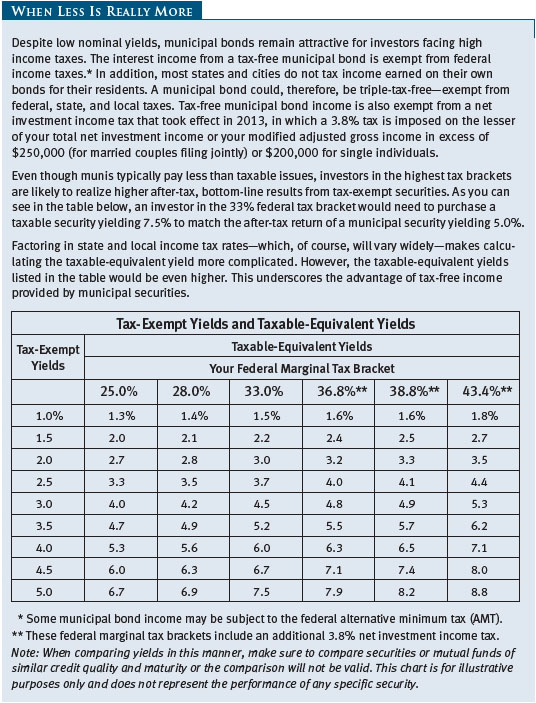
MUNICIPAL MARKET NEWS
Total year-to-date municipal bond issuance through the end of August was about $256 billion, according to The Bond Buyer, which was 15% lower than the same period in 2016. A sharp drop in refunding issuance drove the decline in supply. Fund flows have been mostly positive during the last six months, which, combined with lower supply, created a strong technical backdrop for muni bonds. Generally, fundamentals for municipal issuers remain solid, and most issuers in the $3.8 trillion municipal bond market have been fiscally responsible. State and local governments in general have been cautious about adding to indebtedness since the 2008 financial crisis, and a strengthening economy has helped tax revenues rebound. Over 60% of the market, as measured by the Bloomberg Barclays Municipal Bond Index, is AAA or AA rated.
Although the market is overwhelmingly high quality, many states and municipalities are grappling with underfunded pensions and other post-employment benefit (OPEB) obligations. New reporting rules from the Governmental Accounting Standards Board are bringing greater transparency to state and local governments’ pension funding gaps, long-term risks that investors often overlooked in the past. We believe the market will increasingly price in higher pension risks as the magnitude of unfunded liabilities becomes more conspicuous.
In credit news, the deteriorating fiscal situation in Illinois drew increased scrutiny as political dysfunction led to yet another budget impasse. Moody’s Investors Service and S&P Global Ratings downgraded Illinois’ general obligation debt to the lowest investment-grade level after the state’s regular legislative session ended on May 31 without a budget. The Democrat-controlled state legislature returned for a special session at the end of June and finally passed a budget despite the objections of Governor Bruce Rauner, a Republican, who had vetoed the deal because of its significant tax increases and lack of long-term reforms.
In May, Puerto Rico’s financial oversight board filed petitions with the U.S. District Court seeking help in restructuring approximately $51 billion in debt issued directly by the island’s central government as well as the commonwealth’s COFINA debt, which is backed by sales tax revenue. In early July, PREPA, the commonwealth’s electric utility, filed for bankruptcy after the oversight board rejected the restructuring agreement that had been reached between the power authority and its creditors. The court filings could lead to the largest restructuring of municipal debt in U.S. history. While credit-challenged muni issuers such as Illinois and Puerto Rico made headlines during our reporting period, the negative news seemed to have little impact on the broader tax-exempt bond market.
Sector performance across the muni market was broadly positive, as revenue bonds narrowly outperformed general obligation debt. We continue to favor bonds backed by a dedicated revenue stream over GOs, as we consider revenue bonds to be largely insulated from the pension funding concerns facing state and local governments. Across our municipal platform, we have an overweight to the higher-yielding health care and transportation revenue-backed sectors, which benefited our portfolios as those sectors outpaced the broad index return. Among investment-grade revenue bonds, all subsectors produced positive returns, with hospital and leasing revenue bonds performing well, while resource recovery bonds lagged. High yield tobacco debt gained more than 7% and was the strongest-performing sector in the muni market.
NEW YORK MARKET NEWS
The New York economy has advanced at a slightly slower pace than the national rate, according to the most recent data. Total employment in the state in July 2017 was over 9.5 million, but New York’s 1.5% employment growth lagged the 1.6% increase for the U.S. The state’s unemployment rate was 4.7% in July 2017, down from 4.9% a year earlier but slightly above the national average. Favorably, New York’s per capita income, as of the end of March, was 122% of the U.S.
The state’s financial position remains satisfactory. For the fiscal year that ended March 31, 2017, the balance of the state’s general fund (the primary operating fund), on a cash basis and including the rainy day and other funds, was $7.2 billion, or a healthy 10.9% of expenses. This reflects a decline from $8.9 billion in fiscal year 2016 as the state dedicated a portion of the sizable bank settlement proceeds to support infrastructure investments. The fiscal year 2018 budget reflects expectations for further infrastructure investment that will reduce reserves to $6.4 billion.
New York is the second most heavily indebted state and ranks fifth for debt per capita at $3,070 and seventh for debt as a percentage of personal income at 5.3%, according to Moody’s 2017 State Debt Medians Report. Nevertheless, unlike many other states, New York’s pension funds are well funded, with an aggregate funded ratio of 95% as of March 31, 2017. However, the Empire State’s aggregate OPEB liability is high at $88 billion and was completely unfunded. Most of New York’s debt is appropriation-backed, meaning that the legislature must approve debt service payments on these obligations annually and has no legal requirement to continue consenting to these expenses.
New York City continues to exhibit good fiscal management. The city had a solid $9.3 billion ending cash balance in fiscal year 2017. The current fiscal year 2018 budget is balanced.
Moody’s Investors Service rates New York State general obligation debt Aa1, while S&P and Fitch both rate the bonds AA+. All three agencies maintain a stable outlook on their respective ratings. New York City’s credit ratings are Aa2 from Moody’s, AA from S&P, and AA from Fitch—all with stable outlooks.
PORTFOLIO REVIEW
New York Tax-Free Money Fund
Your fund returned 0.13% in the six-month period ended August 31, 2017, while its peer group, the Lipper New York Tax-Exempt Money Market Funds Index, returned 0.16%.
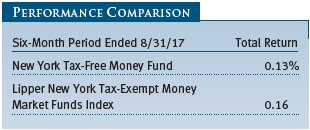
After the Fed’s two interest rate hikes this year, the overall level of short-term municipal rates has moved higher. But the impact on the municipal money market from these rate increases has been somewhat muted due in part to the continued uncertainty about the frequency and timing of future rate increases, as well as by the continued interest of nontraditional buyers of short-term municipal paper. As interest rates move higher, variable rate demand notes (VRDNs), in particular, have remained attractive to nontraditional investors, including taxable money funds, due to yields that are comparable to taxable securities and possess other attractive liquidity attributes, though this effect seemed to be fading as the period ended.
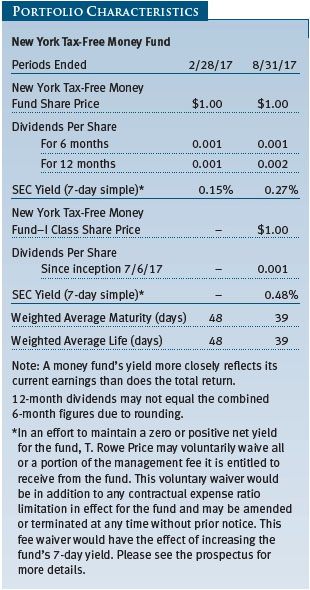
Demand for tax-exempt paper from higher-tax states such as New York has pressured local rates more than the national average. Since our last report, overnight New York yields have averaged about 0.73%, while seven-day New York yields have averaged about 0.81%. On the longer end of the money market yield curve, separately managed accounts (SMAs) seeking cash alternatives have been active buyers of bonds with maturities of six to 12 months. While most yields on one-year maturities have generally moved higher, yields on longer New York paper have actually moved lower to around 0.80%, as the increased demand from these nontraditional buyers has held down yields. This may also be explained in part by tax relationships reasserting themselves after a long period of near-zero rates; investors are again seeing the value of tax-exempt income as short rates move higher.
We have focused on building positions in the front end of the yield curve, avoiding what we deem as overly rich levels in longer maturities. The fund’s commercial paper exposure is higher than it was at the end of February, while bond and note positions are lower. We believe that as the market and its technical influences adjust, a steeper money market yield curve will offer a better entry point into longer positions.
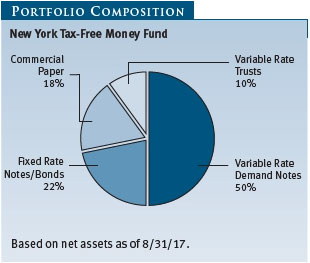

As always, credit quality plays a significant part in asset selection for the New York Tax-Free Money Fund. Currently, we have higher exposures to hospital, dedicated tax, and housing revenue credits. Some prominent positions in the portfolio include Cornell University, New York City Transitional Finance Authority, and the New York City Housing Finance Authority. (Please refer to the fund’s portfolio of investments for a complete list of holdings and the amount each represents in the portfolio.)
Looking ahead, there are reasons to think that further increases in short-term yields may come at a slower pace than previously expected. Early optimism around the possibilities of the administration bringing about fiscal stimulus through infrastructure spending and tax reform at both the corporate and individual levels has faded as the year has progressed. And with it, expectations that the Fed would systematically move short-term rates higher have also faded. Inflation remains subdued, and the recent hurricanes suggest at least some distortions in the upcoming economic data. Although the Fed will soon begin shrinking its balance sheet, the reasons to delay the next short-term rate increase continue to accumulate.
As always, we remain committed to managing a highly liquid, diversified portfolio focused on liquidity and stability of principal, which we deem of utmost importance to our valued shareholders.
New York Tax-Free Bond Fund
The New York Tax-Free Bond Fund returned 3.45% for the six-month period ended August 31, 2017, performing in line with the Lipper New York Municipal Debt Funds Average, which returned 3.47%. The Bloomberg Barclays Municipal Bond Index, which tracks the broader tax-free bond market, posted a return of 3.79%.
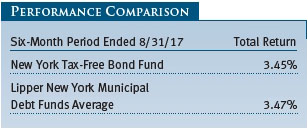
Over a longer time horizon, the fund’s performance versus its peers is solid, placing it in the top quintile in the trailing 10-year period. Based on cumulative total return, Lipper ranked the New York Tax-Free Bond Fund 26 of 90, 37 of 89, 25 of 82, and 11 of 60 funds in the New York municipal debt funds universe for the 1-, 3-, 5-, and 10-year periods ended August 31, 2017, respectively. (Past performance cannot guarantee future results.)
The fund’s weighted average maturity finished the period slightly shorter than it was at the start of the period, while the fund’s duration was unchanged. Our average duration was modestly shorter than the benchmark’s during the period, which detracted from results as yields moved lower across the yield curve. In terms of yield curve positioning, we maintained an overweight to bonds with maturities of 20 years and longer relative to the benchmark. We believe our duration positioning provides some protection against a volatile rate environment, while our overweight in the long end of the curve offers the potential for higher income.
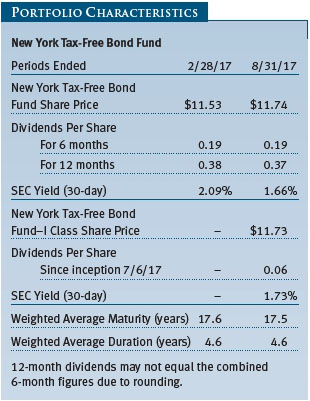

We continue to favor revenue bonds over GO debt in light of our long-held concerns that many municipalities will face challenges related to increased pension and health care liabilities. Revenue-backed education and transportation bonds—sectors where we can often find higher yields—represent just over a third of the portfolio’s net assets.
During the period, we added to special tax bonds, purchasing securities issued by the New York City Transitional Finance Authority, while reducing our position in the health care sector. We eliminated our position in Westchester Medical Center, based on our view that the credit fundamentals of the issuer were weakening. We also eliminated our position in TSASC, a tobacco settlement bond, based on a deteriorating fundamental outlook for the bond. In the education sector, we initiated a position in Union College. (Please refer to the fund’s portfolio of investments for a complete list of holdings and the amount each represents in the portfolio.)
Our allocation to the prerefunded sector rose during the period as a number of our holdings were refinanced by their issuers and recategorized into this sector. Prerefunded bonds provide the fund with another source of liquidity in addition to cash, which we believe is appropriate within the current rate environment, and leaves us well positioned to take advantage of the possibility of further interest rate increases.
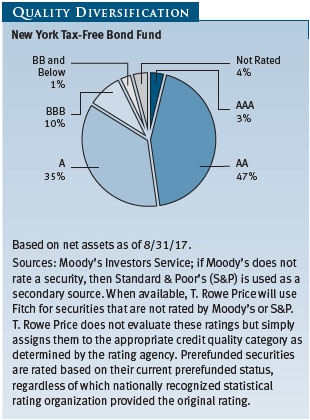
We added to our position in AA rated bonds during the period, and high-quality AAA and AA holdings now make up half the portfolio. However, we continue to overweight A and BBB rated debt as we believe this is an area where our credit research team can find investment opportunities that offer incremental risk-adjusted yield. We maintained a modest exposure to below investment-grade and unrated bonds.
OUTLOOK
We believe that the municipal bond market remains a high-quality market that offers good opportunities for long-term investors seeking tax-free income. While the uncertainties surrounding tax reform and the increased chance of rising yields represent near-term headwinds for broad muni market performance, in our view fundamentals are sound overall, and global economic uncertainties could spur demand for the asset class. As the Fed continues on the path to interest rate normalization, muni bond yields are likely to rise along with Treasury yields—although probably not to the same extent. While higher yields pressure bond prices, munis should be less susceptible than Treasuries to slowly rising rates given their attractive tax-equivalent yields and the steady demand for tax-exempt income. We expect any potential Fed rate increases to be gradual and modest and believe we could remain in a relatively low rate environment for some time.
While we believe that many states deserve high credit ratings and will be able to continue servicing their debts, we have longer-term concerns about significant funding shortfalls for pensions and OPEB obligations in some jurisdictions. These funding gaps stem from investment losses during the 2008 financial crisis, insufficient plan contributions over time, and unrealistic return assumptions. Although few large plans are at risk of insolvency in the near term, the magnitude of unfunded liabilities is becoming more conspicuous in a few states.
Ultimately, we believe independent credit research is our greatest strength and will remain an asset for our investors as we navigate the current market environment. As always, we focus on finding attractively valued bonds issued by municipalities with good long-term fundamentals—an investment strategy that we believe will continue to serve our investors well.
Thank you for investing with T. Rowe Price.
Respectfully submitted,

Joseph K. Lynagh
Chairman of the Investment Advisory Committee
New York Tax-Free Money Fund

Konstantine B. Mallas
Chairman of the Investment Advisory Committee
New York Tax-Free Bond Fund
September 19, 2017
The committee chairmen have day-to-day responsibility for managing the portfolios and work with committee members in developing and executing the funds’ investment programs.
RISKS OF INVESTING IN MONEY MARKET SECURITIES
You could lose money by investing in the Fund. Although the Fund seeks to preserve the value of your investment at $1.00 per share, it cannot guarantee it will do so. The Fund may impose a fee upon the sale of your shares or may temporarily suspend your ability to sell shares if the Fund’s liquidity falls below required minimums because of market conditions or other factors. An investment in the Fund is not insured or guaranteed by the Federal Deposit Insurance Corporation or any other government agency. The Fund’s sponsor has no legal obligation to provide financial support to the Fund, and you should not expect that the sponsor will provide financial support to the Fund at any time.
RISKS OF INVESTING IN FIXED INCOME SECURITIES
Bonds are subject to interest rate risk (the decline in bond prices that usually accompanies a rise in interest rates) and credit risk (the chance that any fund holding could have its credit rating downgraded or that a bond issuer will default by failing to make timely payments of interest or principal), potentially reducing the fund’s income level and share price. The fund is less diversified than one investing nationally. Some income may be subject to state and local taxes and the federal alternative minimum tax.
GLOSSARY
Basis point: One one-hundredth of one percentage point, or 0.01%.
Bloomberg Barclays Municipal Bond Index: A broadly diversified index of tax-exempt bonds.
Bloomberg Barclays U.S. Aggregate Bond Index: An unmanaged index that tracks domestic investment-grade bonds, including corporate, government, and mortgage-backed securities.
Duration: A measure of a bond fund’s sensitivity to changes in interest rates. For example, a fund with a duration of five years would fall about 5% in price in response to a one-percentage-point rise in interest rates, and vice versa.
Federal funds rate (or target rate): The interest rate charged on overnight loans of reserves by one financial institution to another in the United States. The Federal Reserve sets a target federal funds rate to affect the direction of interest rates.
General obligation (GO) debt: A government’s strongest pledge that obligates its full faith and credit, including, if necessary, its ability to raise taxes.
Lipper averages: The averages of available mutual fund performance returns for specified time periods in categories defined by Lipper Inc.
Lipper indexes: Fund benchmarks that consist of a small number (10 to 30) of the largest mutual funds in a particular category as tracked by Lipper Inc.
Other post-employment benefits (OPEB): Benefits paid to an employee after retirement, such as premiums for life and health insurance.
Prerefunded bond: A bond that originally may have been issued as a general obligation or revenue bond but that is now secured by an escrow fund consisting entirely of direct U.S. government obligations that are sufficient for paying the bondholders.
Revenue (or revenue-backed) bond: A bond issued to fund specific projects, such as airports, bridges, hospitals, or toll roads, where a portion of the revenue generated is used to service the interest payments on the bonds.
SEC yield (7-day): A method of calculating a money fund’s yield by annualizing the fund’s net investment income for the last seven days of each period divided by the fund’s net asset value at the end of the period. Yield will vary and is not guaranteed.
SEC yield (30-day): A method of calculating a fund’s yield that assumes all portfolio securities are held until maturity. Yield will vary and is not guaranteed.
Variable rate demand note (VRDN): Generally, a debt security that requires the issuer to redeem at the holder’s discretion on a specified date or dates prior to maturity. Upon redemption, the issuer pays par to the holder who loses future coupon payments that might otherwise be due. The VRDN might be especially attractive at times of rising rates, to protect against interest rate risk by redeeming at par value and reinvesting proceeds in a new bond.
Weighted average life: A measure of a fund’s credit quality risk. In general, the longer the average life, the greater the fund’s credit quality risk. The average life is the dollar-weighted average maturity of a portfolio’s individual securities without taking into account interest rate readjustment dates. Money funds must maintain a weighted average life of less than 120 days.
Weighted average maturity: A measure of a fund’s interest rate sensitivity. In general, the longer the average maturity, the greater the fund’s sensitivity to interest rate changes. The weighted average maturity may take into account the interest rate readjustment dates for certain securities. Money funds must maintain a weighted average maturity of less than 60 days.
Yield curve: A graph depicting the relationship between yields and maturity dates for a set of similar securities. A security with a longer maturity usually has a higher yield. If a short-term security offers a higher yield, then the curve is said to be “inverted.” If short- and long-term bonds are offering equivalent yields, then the curve is said to be “flat.”
Performance and Expenses
| Growth of $10,000 |
This chart shows the value of a hypothetical $10,000 investment in the fund over the past 10 fiscal year periods or since inception (for funds lacking 10-year records). The result is compared with benchmarks, which may include a broad-based market index and a peer group average or index. Market indexes do not include expenses, which are deducted from fund returns as well as mutual fund averages and indexes.
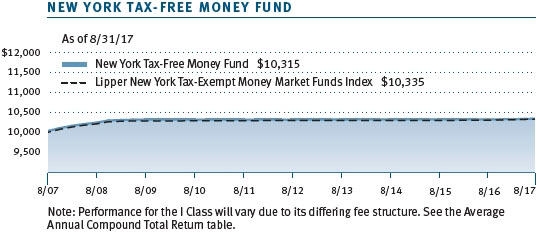
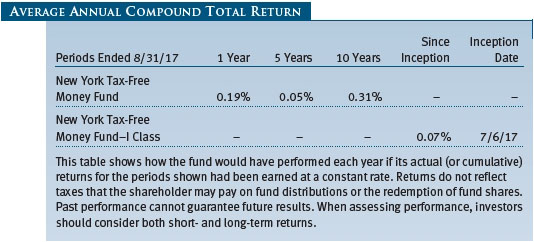
| Growth of $10,000 |
This chart shows the value of a hypothetical $10,000 investment in the fund over the past 10 fiscal year periods or since inception (for funds lacking 10-year records). The result is compared with benchmarks, which may include a broad-based market index and a peer group average or index. Market indexes do not include expenses, which are deducted from fund returns as well as mutual fund averages and indexes.


| Fund Expense Example |
As a mutual fund shareholder, you may incur two types of costs: (1) transaction costs, such as redemption fees or sales loads, and (2) ongoing costs, including management fees, distribution and service (12b-1) fees, and other fund expenses. The following example is intended to help you understand your ongoing costs (in dollars) of investing in the fund and to compare these costs with the ongoing costs of investing in other mutual funds. The example is based on an investment of $1,000 invested at the beginning of the most recent six-month period and held for the entire period.
Please note that the fund has two share classes: The original share class (Investor Class) charges no distribution and service (12b-1) fee, and the I Class shares are also available to institutionally oriented clients and impose no 12b-1 or administrative fee payment. Each share class is presented separately in the table.
Actual Expenses
The first line of the following table (Actual) provides information about actual account values and expenses based on the fund’s actual returns. You may use the information on this line, together with your account balance, to estimate the expenses that you paid over the period. Simply divide your account value by $1,000 (for example, an $8,600 account value divided by $1,000 = 8.6), then multiply the result by the number on the first line under the heading “Expenses Paid During Period” to estimate the expenses you paid on your account during this period.
Hypothetical Example for Comparison Purposes
The information on the second line of the table (Hypothetical) is based on hypothetical account values and expenses derived from the fund’s actual expense ratio and an assumed 5% per year rate of return before expenses (not the fund’s actual return). You may compare the ongoing costs of investing in the fund with other funds by contrasting this 5% hypothetical example and the 5% hypothetical examples that appear in the shareholder reports of the other funds. The hypothetical account values and expenses may not be used to estimate the actual ending account balance or expenses you paid for the period.
Note: T. Rowe Price charges an annual account service fee of $20, generally for accounts with less than $10,000. The fee is waived for any investor whose T. Rowe Price mutual fund accounts total $50,000 or more; accounts electing to receive electronic delivery of account statements, transaction confirmations, prospectuses, and shareholder reports; or accounts of an investor who is a T. Rowe Price Personal Services or Enhanced Personal Services client (enrollment in these programs generally requires T. Rowe Price assets of at least $250,000). This fee is not included in the accompanying table. If you are subject to the fee, keep it in mind when you are estimating the ongoing expenses of investing in the fund and when comparing the expenses of this fund with other funds.
You should also be aware that the expenses shown in the table highlight only your ongoing costs and do not reflect any transaction costs, such as redemption fees or sales loads. Therefore, the second line of the table is useful in comparing ongoing costs only and will not help you determine the relative total costs of owning different funds. To the extent a fund charges transaction costs, however, the total cost of owning that fund is higher.
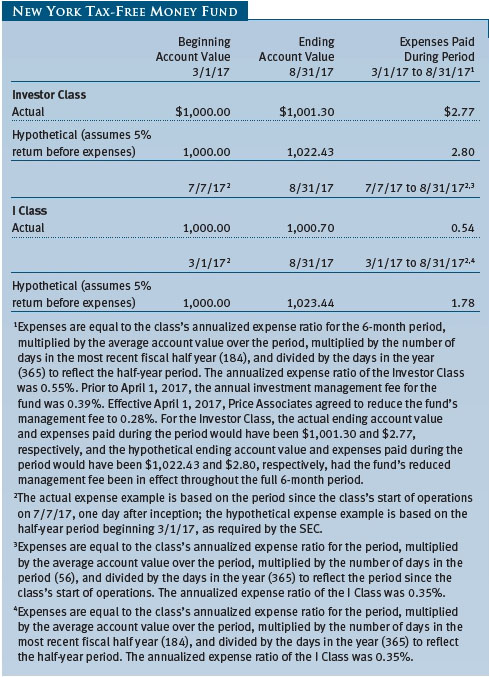
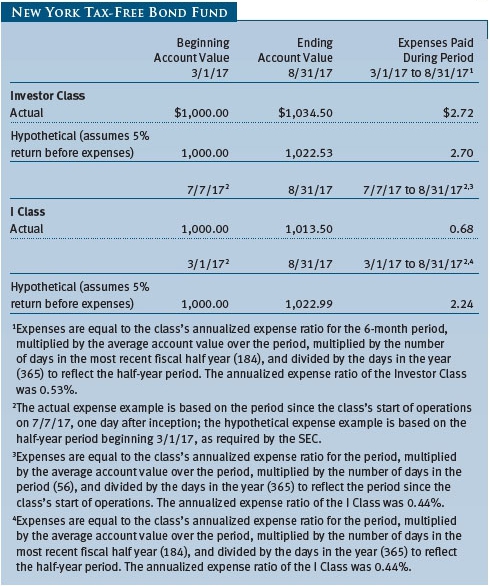

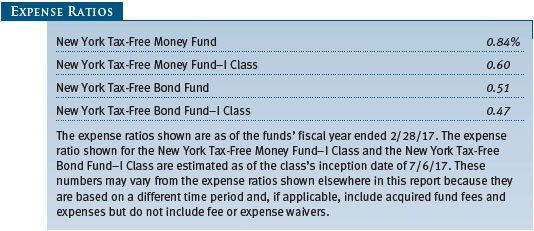
Unaudited
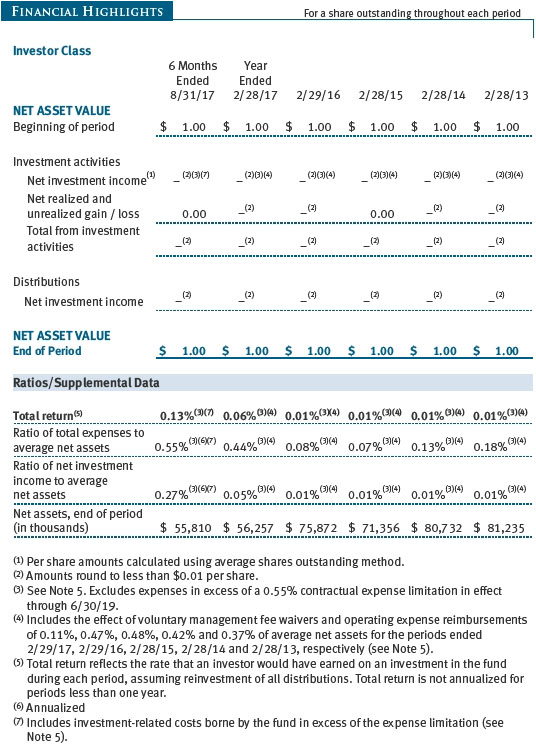
The accompanying notes are an integral part of these financial statements.
Unaudited

The accompanying notes are an integral part of these financial statements.
Unaudited
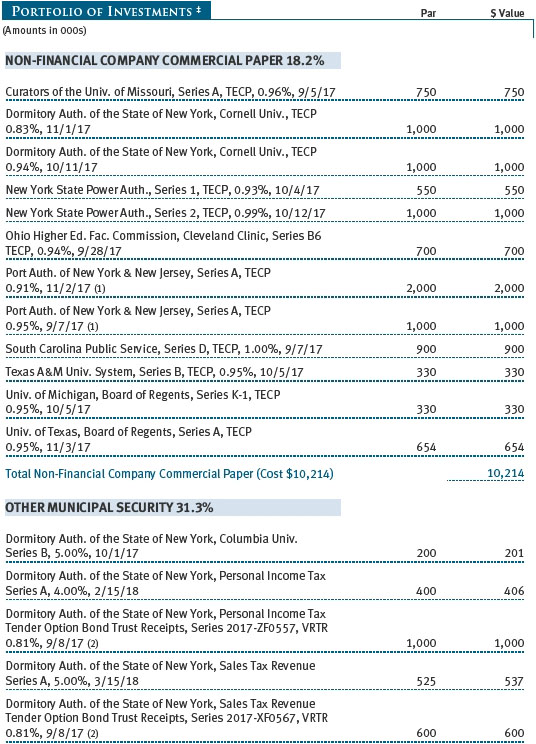

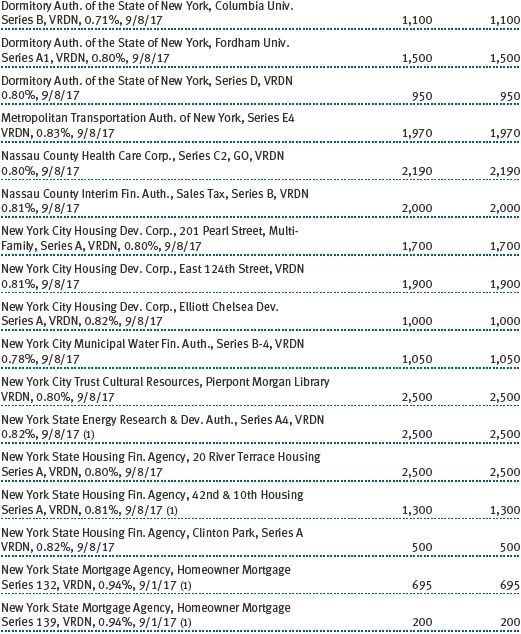
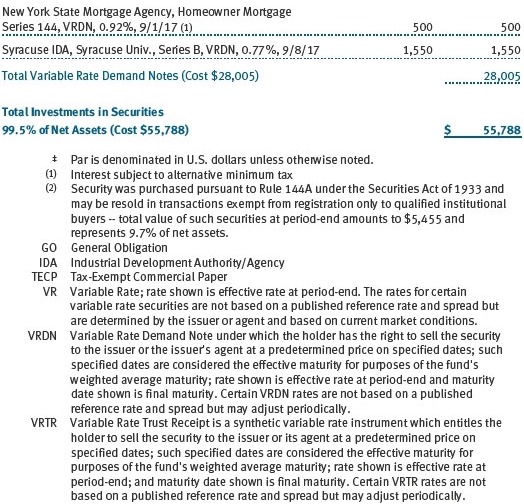
The accompanying notes are an integral part of these financial statements.
Unaudited

The accompanying notes are an integral part of these financial statements.
Unaudited

The accompanying notes are an integral part of these financial statements.
Unaudited
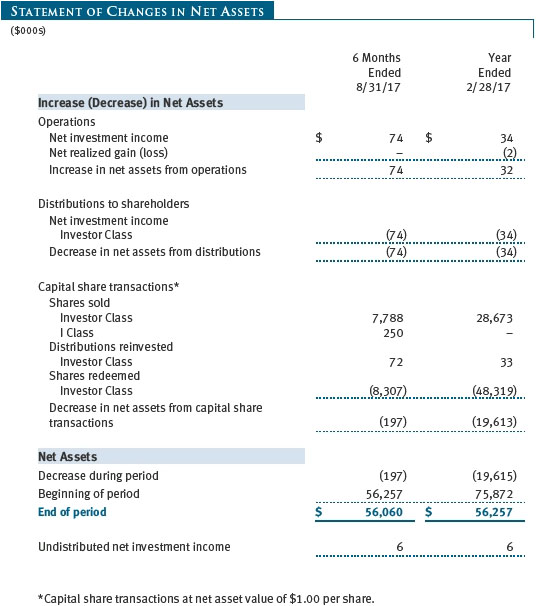
The accompanying notes are an integral part of these financial statements.
Unaudited
| Notes to Financial Statements |
T. Rowe Price State Tax-Free Income Trust (the trust) is registered under the Investment Company Act of 1940 (the 1940 Act). The New York Tax-Free Money Fund (the fund) is a diversified, open-end management investment company established by the trust. The fund seeks to provide preservation of capital, liquidity, and, consistent with these objectives, the highest level of income exempt from federal, New York state, and New York City income taxes. The fund intends to operate as a retail money market fund and has the ability to impose liquidity fees on redemptions and/or temporarily suspend redemptions. The fund has two classes of shares: the New York Tax-Free Money Fund (Investor Class) and the New York Tax-Free Money Fund-I Class (I Class). I Class shares generally are available only to investors meeting a $1,000,000 minimum investment or certain other criteria. Each class has exclusive voting rights on matters related solely to that class; separate voting rights on matters that relate to both classes; and, in all other respects, the same rights and obligations as the other class.
NOTE 1 - SIGNIFICANT ACCOUNTING POLICIES
Basis of Preparation The fund is an investment company and follows accounting and reporting guidance in the Financial Accounting Standards Board (FASB) Accounting Standards Codification Topic 946 (ASC 946). The accompanying financial statements were prepared in accordance with accounting principles generally accepted in the United States of America (GAAP), including, but not limited to, ASC 946. GAAP requires the use of estimates made by management. Management believes that estimates and valuations are appropriate; however, actual results may differ from those estimates, and the valuations reflected in the accompanying financial statements may differ from the value ultimately realized upon sale or maturity.
Investment Transactions, Investment Income, and Distributions Income and expenses are recorded on the accrual basis. Premiums and discounts on debt securities are amortized for financial reporting purposes. Income tax-related interest and penalties, if incurred, would be recorded as income tax expense. Investment transactions are accounted for on the trade date. Realized gains and losses are reported on the identified cost basis. Income distributions are declared by each class daily and paid monthly. Distributions to shareholders are recorded on the ex-dividend date. A capital gain distribution may also be declared and paid by the fund annually.
Class Accounting Shareholder servicing, prospectus, and shareholder report expenses incurred by each class are charged directly to the class to which they relate. Expenses common to both classes and investment income are allocated to the classes based upon the relative daily net assets of each class’s settled shares; realized and unrealized gains and losses are allocated based upon the relative daily net assets of each class’s outstanding shares.
New Accounting Guidance In March 2017, the FASB issued amended guidance to shorten the amortization period for certain callable debt securities, held at a premium. The guidance is effective for fiscal years and interim periods beginning after December 15, 2018. Adoption will have no effect on the fund’s net assets or results of operations.
On August 1, 2017, the fund implemented amendments to Regulation S-X, issued by the Securities and Exchange Commission, which require standardized, enhanced disclosures, particularly related to derivatives, in investment company financial statements. Adoption had no effect on the fund’s net assets or results of operations.
NOTE 2 - VALUATION
The fund’s financial instruments are valued and each class’s net asset value (NAV) per share is computed at the close of the New York Stock Exchange (NYSE), normally 4 p.m. ET, each day the NYSE is open for business. However, the NAV per share may be calculated at a time other than the normal close of the NYSE if trading on the NYSE is restricted, if the NYSE closes earlier, or as may be permitted by the SEC. The fund’s financial instruments are reported at fair value, which GAAP defines as the price that would be received to sell an asset or paid to transfer a liability in an orderly transaction between market participants at the measurement date. Assets and liabilities other than financial instruments, including short-term receivables and payables, are carried at cost, or estimated realizable value, if less, which approximates fair value. The T. Rowe Price Valuation Committee (the Valuation Committee) is an internal committee that has been delegated certain responsibilities by the fund’s Board of Trustees (the Board) to ensure that financial instruments are appropriately priced at fair value in accordance with GAAP and the 1940 Act. Subject to oversight by the Board, the Valuation Committee develops and oversees pricing-related policies and procedures and approves all fair value determinations.
Various valuation techniques and inputs are used to determine the fair value of financial instruments. GAAP establishes the following fair value hierarchy that categorizes the inputs used to measure fair value:
Level 1 – quoted prices (unadjusted) in active markets for identical financial instruments that the fund can access at the reporting date
Level 2 – inputs other than Level 1 quoted prices that are observable, either directly or indirectly (including, but not limited to, quoted prices for similar financial instruments in active markets, quoted prices for identical or similar financial instruments in inactive markets, interest rates and yield curves, implied volatilities, and credit spreads)
Level 3 – unobservable inputs
Observable inputs are developed using market data, such as publicly available information about actual events or transactions, and reflect the assumptions market participants would use to price the financial instrument. Unobservable inputs are those for which market data are not available and are developed using the best information available about the assumptions that market participants would use to price the financial instrument. GAAP requires valuation techniques to maximize the use of relevant observable inputs and minimize the use of unobservable inputs. Input levels are not necessarily an indication of the risk or liquidity associated with financial instruments at that level but rather the degree of judgment used in determining those values. For example, securities held by a money market fund are generally high quality and liquid; however, they are reflected as Level 2 because the inputs used to determine fair value are not quoted prices in an active market.
In accordance with Rule 2a-7 under the 1940 Act, the fund values its securities at amortized cost, which approximates fair value. Securities for which amortized cost is deemed not to reflect fair value are stated at fair value as determined in good faith by the Valuation Committee. On August 31, 2017, all of the fund’s financial instruments were classified as Level 2 in the fair value hierarchy.
NOTE 3 - OTHER INVESTMENT TRANSACTIONS
Consistent with its investment objective, the fund engages in the following practices to manage exposure to certain risks and/or to enhance performance. The investment objective, policies, program, and risk factors of the fund are described more fully in the fund’s prospectus and Statement of Additional Information.
Restricted Securities The fund may invest in securities that are subject to legal or contractual restrictions on resale. Prompt sale of such securities at an acceptable price may be difficult and may involve substantial delays and additional costs.
NOTE 4 - FEDERAL INCOME TAXES
No provision for federal income taxes is required since the fund intends to continue to qualify as a regulated investment company under Subchapter M of the Internal Revenue Code and distribute to shareholders all of its income and gains. Distributions determined in accordance with federal income tax regulations may differ in amount or character from net investment income and realized gains for financial reporting purposes. Financial reporting records are adjusted for permanent book/tax differences to reflect tax character but are not adjusted for temporary differences. The amount and character of tax-basis distributions and composition of net assets are finalized at fiscal year-end; accordingly, tax-basis balances have not been determined as of the date of this report.
The fund intends to retain realized gains to the extent of available capital loss carryforwards. Net realized capital losses may be carried forward indefinitely to offset future realized capital gains. As of February 28, 2017, the fund had $2,000 of available capital loss carryforwards.
At August 31, 2017, the cost of investments for federal income tax purposes was $55,788,000.
NOTE 5 - RELATED PARTY TRANSACTIONS
The fund is managed by T. Rowe Price Associates, Inc. (Price Associates), a wholly owned subsidiary of T. Rowe Price Group, Inc. (Price Group). The investment management agreement between the fund and Price Associates provides for an annual investment management fee, which is computed daily and paid monthly. The fee consists of an individual fund fee, equal to 0.10% of the fund’s average daily net assets, and a group fee. The group fee rate is calculated based on the combined net assets of certain mutual funds sponsored by Price Associates (the group) applied to a graduated fee schedule, with rates ranging from 0.48% for the first $1 billion of assets to 0.265% for assets in excess of $650 billion. The fund’s group fee is determined by applying the group fee rate to the fund’s average daily net assets. At August 31, 2017, the effective annual group fee rate was 0.29%. Effective April 1, 2017, Price Associates agreed to reduce the fund’s annual investment management fee to 0.28% through September 30, 2019. This contractual arrangement will renew automatically for one-year terms thereafter and may be revised, revoked, or terminated only with approval of the fund’s Board. The fund has no obligation to repay fees reduced under this arrangement.
The Investor Class subject to a contractual expense limitation through June 30, 2019. During the limitation period, Price Associates is required to waive its management fee and pay the fund for any expenses (excluding interest, expenses related to borrowings, taxes, brokerage, and other non-recurring expenses permitted by the investment management agreement) that would otherwise cause the fund’s ratio of annualized total expenses to average net assets (expense ratio) to exceed its expense limitation of 0.55%. For a period of three years after the date of any payment or waiver, the fund may repay Price Associates for expenses previously paid to the extent the fund’s net assets grow or expenses decline sufficiently to allow repayment without causing the fund’s expense ratio (after the repayment is taken into account) to exceed the lesser of: (1) the expense limitation in place at the time such amounts were paid; and (2) the class’s current expense limitation. Such repayment is subject to shareholder approval.
The I Class is also subject to an operating expense limitation (I Class limit) pursuant to which Price Associates is contractually required to pay all operating expenses of the I Class, excluding management fees, interest, expenses related to borrowings, taxes, brokerage, and other non-recurring expenses permitted by the investment management agreement, to the extent such operating expenses, on an annualized basis, exceed 0.05% of average net assets. This agreement will continue until June 30, 2019, and may be renewed, revised, or revoked only with approval of the fund’s Board. The I Class is required to repay Price Associates for expenses previously paid to the extent the class’s net assets grow or expenses decline sufficiently to allow repayment without causing the class’s operating expense ratio (after the repayment is taken into account) to exceed the lesser of: (1) the expense limitation in place at the time such amounts were paid; and (2) the class’s current expense limitation. However, no repayment will be made more than three years after the date of a payment or waiver.
Pursuant to these agreements, $156,000 of expenses were waived/paid by Price Associates during the six months ended August 31, 2017. Including this amount, expenses previously waived/paid by Price Associates in the amount of $549,000 remain subject to repayment by the fund at August 31, 2017.
Price Associates may voluntarily waive all or a portion of its management fee and reimburse operating expenses to the extent necessary for the fund to maintain a zero or positive net yield (voluntary waiver). This voluntary waiver is in addition to the contractual expense limit in effect for the fund. Any amounts waived/paid by Price Associates under this voluntary agreement are not subject to repayment by the fund. Price Associates may amend or terminate this voluntary arrangement at any time without prior notice.
In addition, the fund has entered into service agreements with Price Associates and a wholly owned subsidiary of Price Associates (collectively, Price). Price Associates provides certain accounting and administrative services to the fund. T. Rowe Price Services, Inc. provides shareholder and administrative services in its capacity as the fund’s transfer and dividend-disbursing agent. For the six months ended August 31, 2017, expenses incurred pursuant to these service agreements were $41,000 for Price Associates and $11,000 for T. Rowe Price Services, Inc. The total amount payable at period-end pursuant to these service agreements is reflected as Due to Affiliates in the accompanying financial statements.
As of August 31, 2017, T. Rowe Price Group, Inc., or its wholly owned subsidiaries owned 250,000 shares of the I Class, representing 100% of the I Class’s net assets.
The fund may participate in securities purchase and sale transactions with other funds or accounts advised by Price Associates (cross trades), in accordance with procedures adopted by the fund’s Board and Securities and Exchange Commission rules, which require, among other things, that such purchase and sale cross trades be effected at the independent current market price of the security. Purchases and sales cross trades aggregated $0 and $885,000, respectively, with net realized gain of $0 for the six months ended August 31, 2017. Generally, cross trades were executed due to the limited supply of high-quality municipal securities available in the market and the adviser’s decision to continue owning certain investments in funds or accounts advised by Price Associates.
| Information on Proxy Voting Policies, Procedures, and Records |
A description of the policies and procedures used by T. Rowe Price funds and portfolios to determine how to vote proxies relating to portfolio securities is available in each fund’s Statement of Additional Information. You may request this document by calling 1-800-225-5132 or by accessing the SEC’s website, sec.gov.
The description of our proxy voting policies and procedures is also available on our corporate website. To access it, please visit the following Web page:
https://www3.troweprice.com/usis/corporate/en/utility/policies.html
Scroll down to the section near the bottom of the page that says, “Proxy Voting Policies.” Click on the Proxy Voting Policies link in the shaded box.
Each fund’s most recent annual proxy voting record is available on our website and through the SEC’s website. To access it through T. Rowe Price, visit the website location shown above, and scroll down to the section near the bottom of the page that says, “Proxy Voting Records.” Click on the Proxy Voting Records link in the shaded box.
| How to Obtain Quarterly Portfolio Holdings |
The fund files a complete schedule of portfolio holdings with the Securities and Exchange Commission for the first and third quarters of each fiscal year on Form N-Q. The fund’s Form N-Q is available electronically on the SEC’s website (sec.gov); hard copies may be reviewed and copied at the SEC’s Public Reference Room, 100 F St. N.E., Washington, DC 20549. For more information on the Public Reference Room, call 1-800-SEC-0330.
| Approval of Investment Management Agreement |
Each year, the fund’s Board of Trustees (Board) considers the continuation of the investment management agreement (Advisory Contract) between the fund and its investment advisor, T. Rowe Price Associates, Inc. (Advisor). In that regard, at an in-person meeting held on March 6–7, 2017 (Meeting), the Board, including a majority of the fund’s independent trustees, approved the continuation of the fund’s Advisory Contract. At the Meeting, the Board considered the factors and reached the conclusions described below relating to the selection of the Advisor and the approval of the Advisory Contract. The independent trustees were assisted in their evaluation of the Advisory Contract by independent legal counsel from whom they received separate legal advice and with whom they met separately.
In providing information to the Board, the Advisor was guided by a detailed set of requests for information submitted by independent legal counsel on behalf of the independent trustees. In considering and approving the Advisory Contract, the Board considered the information it believed was relevant, including, but not limited to, the information discussed below. The Board considered not only the specific information presented in connection with the Meeting but also the knowledge gained over time through interaction with the Advisor about various topics. The Board meets regularly and, at each of its meetings, covers an extensive agenda of topics and materials and considers factors that are relevant to its annual consideration of the renewal of the T. Rowe Price funds’ advisory contracts, including performance and the services and support provided to the funds and their shareholders.
Services Provided by the Advisor
The Board considered the nature, quality, and extent of the services provided to the fund by the Advisor. These services included, but were not limited to, directing the fund’s investments in accordance with its investment program and the overall management of the fund’s portfolio, as well as a variety of related activities such as financial, investment operations, and administrative services; compliance; maintaining the fund’s records and registrations; and shareholder communications. The Board also reviewed the background and experience of the Advisor’s senior management team and investment personnel involved in the management of the fund, as well as the Advisor’s compliance record. The Board concluded that it was satisfied with the nature, quality, and extent of the services provided by the Advisor.
Investment Performance of the Fund
The Board took into account discussions with the Advisor and reports that it receives throughout the year relating to fund performance. In connection with the Meeting, the Board reviewed the fund’s net annualized total returns for the 1-, 2-, 3-, 4-, 5-, and 10-year periods as of September 30, 2016, and compared these returns with the performance of a peer group of funds with similar investment programs and a wide variety of other previously agreed-upon comparable performance measures and market data, including those supplied by Broadridge, which is an independent provider of mutual fund data.
On the basis of this evaluation and the Board’s ongoing review of investment results, and factoring in the relative market conditions during certain of the performance periods, the Board concluded that the fund’s performance was satisfactory.
Costs, Benefits, Profits, and Economies of Scale
The Board reviewed detailed information regarding the revenues received by the Advisor under the Advisory Contract and other benefits that the Advisor (and its affiliates) may have realized from its relationship with the fund, including any research received under “soft dollar” agreements and commission-sharing arrangements with broker-dealers. The Board considered that the Advisor may receive some benefit from soft-dollar arrangements pursuant to which research is received from broker-dealers that execute the fund’s portfolio transactions. The Board received information on the estimated costs incurred and profits realized by the Advisor from managing the T. Rowe Price funds. While the Board did not review information regarding profits realized from managing the fund in particular because the fund had not recognized sufficient revenues to produce meaningful profit margin percentages, the Board concluded that the Advisor’s profits were reasonable in light of the services provided to the T. Rowe Price funds.
The Board also considered whether the fund benefits under the fee levels set forth in the Advisory Contract from any economies of scale realized by the Advisor. Under the Advisory Contract, the fund pays a fee to the Advisor for investment management services composed of two components—a group fee rate based on the combined average net assets of most of the T. Rowe Price funds (including the fund) that declines at certain asset levels and an individual fund fee rate based on the fund’s average daily net assets—and the fund pays its own expenses of operations (subject to a contractual limitation on the fund’s total expense ratio). At the Meeting, the Board approved an additional 0.005% breakpoint to the group fee schedule, effective May 1, 2017. With the new breakpoint, the group fee rate will decline to 0.265% when the combined average net assets of the applicable T. Rowe Price funds exceed $650 billion.
Also at the Meeting, the Board approved a contractual arrangement under which the Advisor agrees to waive a portion of the management fee it is entitled to receive from the fund in order to limit the fund’s overall management fee rate to 0.28% of the fund’s average daily net assets. This arrangement will be in place at least through June 30, 2019, at which point the limitation may be renewed or lapsed. In addition to the contractual expense limitations, the Board also noted that an arrangement was already in place whereby the Advisor may voluntarily waive all or a portion of the management fee it is entitled to receive from the fund or pay all or a portion of the fund’s operating expenses in order to maintain a zero or positive net yield for the fund. The Board concluded that the advisory fee structure for the fund continued to provide for a reasonable sharing of benefits from any economies of scale with the fund’s investors.
Fees and Expenses
The Board was provided with information regarding industry trends in management fees and expenses. Among other things, the Board reviewed data for peer groups that were compiled by Broadridge, which compared: (i) contractual management fees, total expenses, actual management fees, and nonmanagement expenses of the fund with a group of competitor funds selected by Broadridge (Expense Group) and (ii) total expenses, actual management fees, and nonmanagement expenses of the fund with a broader set of funds within the Lipper investment classification (Expense Universe). The Board considered the fund’s contractual management fee rate, actual management fee rate (which reflects the management fees actually received from the fund by the Advisor after any applicable waivers, reductions, or reimbursements), operating expenses, and total expenses (which reflect the net total expense ratio of the fund after any waivers, reductions, or reimbursements) in comparison with the information for the Broadridge peer groups. Broadridge generally constructed the peer groups by seeking the most comparable funds based on similar investment classifications and objectives, expense structure, asset size, and operating components and attributes and ranked funds into quintiles, with the first quintile representing the funds with the lowest relative expenses and the fifth quintile representing the funds with the highest relative expenses. The information provided to the Board indicated that the fund’s contractual management fee ranked in the second quintile (Expense Group), the fund’s actual management fee rate ranked in the first quintile (Expense Group and Expense Universe), and the fund’s total expenses ranked in the third and fourth quintiles (Expense Group) and the second and third quintiles (Expense Universe).
The Board also reviewed the fee schedules for institutional accounts and private accounts with similar mandates that are advised or subadvised by the Advisor and its affiliates. Management provided the Board with information about the Advisor’s responsibilities and services provided to subadvisory and other institutional account clients, including information about how the requirements and economics of the institutional business are fundamentally different from those of the mutual fund business. The Board considered information showing that the Advisor’s mutual fund business is generally more complex from a business and compliance perspective than its institutional account business and considered various relevant factors, such as the broader scope of operations and oversight, more extensive shareholder communication infrastructure, greater asset flows, heightened business risks, and differences in applicable laws and regulations associated with the Advisor’s proprietary mutual fund business. In assessing the reasonableness of the fund’s management fee rate, the Board considered the differences in the nature of the services required for the Advisor to manage its mutual fund business versus managing a discrete pool of assets as a subadvisor to another institution’s mutual fund or for an institutional account and that the Advisor generally performs significant additional services and assumes greater risk in managing the fund and other T. Rowe Price funds than it does for institutional account clients.
On the basis of the information provided and the factors considered, the Board concluded that the fees paid by the fund under the Advisory Contract are reasonable.
Approval of the Advisory Contract
As noted, the Board approved the continuation of the Advisory Contract. No single factor was considered in isolation or to be determinative to the decision. Rather, the Board concluded, in light of a weighting and balancing of all factors considered, that it was in the best interests of the fund and its shareholders for the Board to approve the continuation of the Advisory Contract (including the fees to be charged for services thereunder).
Item 2. Code of Ethics.
A code of ethics, as defined in Item 2 of Form N-CSR, applicable to its principal executive officer, principal financial officer, principal accounting officer or controller, or persons performing similar functions is filed as an exhibit to the registrant’s annual Form N-CSR. No substantive amendments were approved or waivers were granted to this code of ethics during the registrant’s most recent fiscal half-year.
Item 3. Audit Committee Financial Expert.
Disclosure required in registrant’s annual Form N-CSR.
Item 4. Principal Accountant Fees and Services.
Disclosure required in registrant’s annual Form N-CSR.
Item 5. Audit Committee of Listed Registrants.
Not applicable.
Item 6. Investments.
(a) Not applicable. The complete schedule of investments is included in Item 1 of this Form N-CSR.
(b) Not applicable.
Item 7. Disclosure of Proxy Voting Policies and Procedures for Closed-End Management Investment Companies.
Not applicable.
Item 8. Portfolio Managers of Closed-End Management Investment Companies.
Not applicable.
Item 9. Purchases of Equity Securities by Closed-End Management Investment Company and Affiliated Purchasers.
Not applicable.
Item 10. Submission of Matters to a Vote of Security Holders.
Not applicable.
Item 11. Controls and Procedures.
(a) The registrant’s principal executive officer and principal financial officer have evaluated the registrant’s disclosure controls and procedures within 90 days of this filing and have concluded that the registrant’s disclosure controls and procedures were effective, as of that date, in ensuring that information required to be disclosed by the registrant in this Form N-CSR was recorded, processed, summarized, and reported timely.
(b) The registrant’s principal executive officer and principal financial officer are aware of no change in the registrant’s internal control over financial reporting that occurred during the registrant’s second fiscal quarter covered by this report that has materially affected, or is reasonably likely to materially affect, the registrant’s internal control over financial reporting.
Item 12. Exhibits.
(a)(1) The registrant’s code of ethics pursuant to Item 2 of Form N-CSR is filed with the registrant’s annual Form N-CSR.
(2) Separate certifications by the registrant's principal executive officer and principal financial officer, pursuant to Section 302 of the Sarbanes-Oxley Act of 2002 and required by Rule 30a-2(a) under the Investment Company Act of 1940, are attached.
(3) Written solicitation to repurchase securities issued by closed-end companies: not applicable.
(b) A certification by the registrant's principal executive officer and principal financial officer, pursuant to Section 906 of the Sarbanes-Oxley Act of 2002 and required by Rule 30a-2(b) under the Investment Company Act of 1940, is attached.
SIGNATURES
Pursuant to the requirements of the Securities Exchange Act of 1934 and the Investment Company Act of 1940, the registrant has duly caused this report to be signed on its behalf by the undersigned, thereunto duly authorized.
T. Rowe Price State Tax-Free Income Trust
| By | /s/ Edward C. Bernard | |||||
| Edward C. Bernard | ||||||
| Principal Executive Officer | ||||||
| Date | October 17, 2017 | |||||
Pursuant to the requirements of the Securities Exchange Act of 1934 and the Investment Company Act of 1940, this report has been signed below by the following persons on behalf of the registrant and in the capacities and on the dates indicated.
| By | /s/ Edward C. Bernard | |||||
| Edward C. Bernard | ||||||
| Principal Executive Officer | ||||||
| Date | October 17, 2017 | |||||
| By | /s/ Catherine D. Mathews | |||||
| Catherine D. Mathews | ||||||
| Principal Financial Officer | ||||||
| Date | October 17, 2017 | |||||